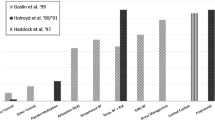Abstract
This report presents the first prospective comparison of the long-term maintenance of reductions in recurrent migraine headaches achieved with (abortive) pharmacological and nonpharmacological (combined relaxation training and thermal biofeedback training) treatments. Nineteen of 21 (90%) successfully treated patients (50% or greater reduction in headache activity) were contacted for follow-up evaluation 3 years later. Migraine sufferers who had been treated with ergotamine were less likely to still be relying on the treatment they had received and more likely to have additional medical treatment for their headaches and to be using prophylactic or narcotic medication than were migraine sufferers who had been treated with relaxation/biofeedback training. However, daily headache recordings revealed that patients in both treatment groups continued to show lower headache activity at 3-year follow-up than prior to treatment. Although preliminary, these findings raise the possibility that improvements achieved with nonpharmacological treatment are more likely to be maintained without additional treatment than are similar improvements achieved with abortive pharmacological treatment.
Similar content being viewed by others
References
Ala-Hurala, V., Myllyla, V., & Hokkanen, E. (1982). Ergotamine abuse: Results of ergotamine discontinuation, with special reference to the plasma concentration.Cephalagia, 2 189–195.
Blanchard, E. B. (1987). Long-term effects of behavioral treatment of chronic headache.Behavior Therapy, 23 375–385.
Blanchard, E. B., & Andrasik, F. (1985). Management of chronic headaches: A psychological approach. New York: Pergamon Press.
Blanchard, E. B., & Schwartz, S. P. (1988). Clinically significantly changes in behavioral medicine.Behavioral Assessment, 10 171–188.
Diamond, S., Kudrow, L., Stevens, J., & Shapiro, D. B. (1982). Long-term study of propranolol in the treatment of migraine.Headache, 22 268–271.
Holroyd, K. A., & Andrasik, F. (1982). Do the effects of cognitive therapy endure? A two-year follow-up of tension headache sufferers treated with cognitive therapy or biofeedback.Cognitive Therapy and Research, 6 325–333.
Holroyd, K., Cordingley, G. E., Pingel, J. D., Jerome, A., Theofanous, M. A., Jackson, D. K., & Leard, L. (1989). Enhancing the effectiveness of abortive therapy: A controlled evaluation self-management training.Headache, 29 148–153.
Holroyd, K. A., Holm, J. E., Hursey, K. G., Penzien, D. B., Cordingley, G. E., Theofanous, A. G., Richardson, S. C., & Tobin, D. L. (1988). Recurrent vascular headache: Home-based behavioral treatment versus abortive pharmacological treatment.Journal of Consulting and Clinical Psychology, 56 218–223.
Holroyd, K. A., Penzien, D. B., Holm, J. E. (1988). Clinical issues in the treatment of recurrent headache disorders. In P. A. Keller & L. G. Ritt (Eds.),Innovations in clinical practice: A source book. (Vol. 7). Sarasota, FL: Professional Resource Exchange.
Mathew, N. T., Stubits, E., & Nigam, M. P. (1982). Transformation of episodic migraine into daily headache: Analysis of factors.Headache, 22 66–68.
Saper, J. R. (1987). Ergotamine dependency — A review.Headache, 27 435–438.
Author information
Authors and Affiliations
Additional information
A Baker Award from Ohio University provided support for the original outcome study.
Abgelo Theofanous with R. L. Associates (Ann Arbor).
Rights and permissions
About this article
Cite this article
Holroyd, K.A., Holm, J.F., Penzien, D.B. et al. Long-term maintenance of improvements achieved with (abortive) pharmacological and nonpharmacological treatments for migraine: Preliminary findings. Biofeedback and Self-Regulation 14, 301–308 (1989). https://doi.org/10.1007/BF00999121
Issue Date:
DOI: https://doi.org/10.1007/BF00999121




